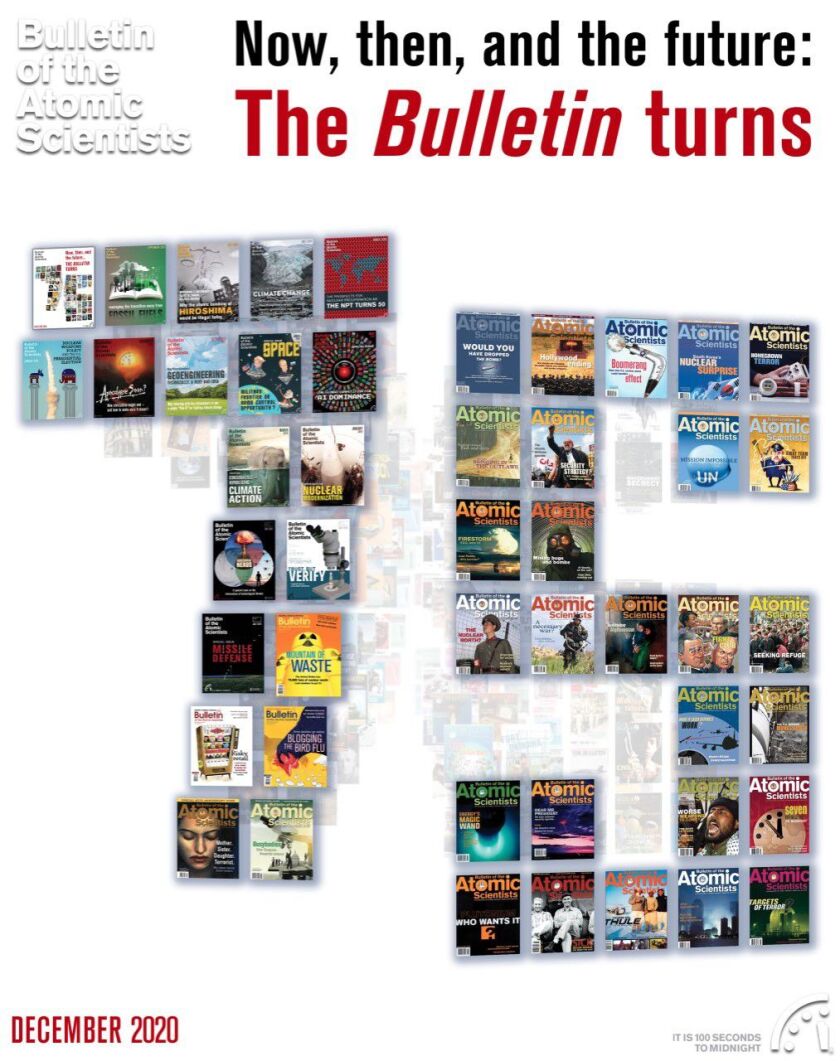Chicago is not only the birthplace of deep dish pizza but atomic energy: the first man-made nuclear fission was achieved in 1942 at the University of Chicago.
So it makes sense that the Bulletin of the Atomic Scientists began here, too, 75 years ago Wednesday.
“What?” you may ask. “Is this not about the clock?” The Bulletin suffers — whoops, benefits — from perhaps the most wag-the-dog publicity gimmick ever created, its “Doomsday Clock.” Originated in 1947 as a way to graphically convey just how close our world is to nuclear disaster, its hands seem to be forever marching closer and closer toward the midnight of Armageddon while never actually getting there.
An effective PR tool, but one so overpowering that you can be forgiven for not quite realizing there is a magazine behind the clock. I didn’t, and my father was an atomic scientist.
The 75th anniversary issue is available online, and a delightful treat, showcasing past articles written by famous figures from Richard Nixon to Albert Einstein.
Nixon pooh-poohs international cooperation as only an old Red-baiter can, writing in 1960, “The road to war is paved with agreements based solely on mutual trust.”
While Einstein lurches the other way, putting more hope in global action in the face of crisis than might be seemly in a refugee from Nazi Germany. Writing in 1950, he’d like “a supra-national judicial and executive body ... set up empowered to decide questions of immediate concern to the security of the nations.”
Don’t miss Hans Bethe’s 1946 “Can air or water be exploded?” Bethe was the guy, while the Manhattan Project was racing ahead, to clear his throat, raise a finger, and observe, “You know, one of us fellows should make double sure that we aren’t going to set fire to the atmosphere and destroy the planet when we try this.”
Speaking of which. William W. Kellogg’s 1978 article, “Is Mankind Warming the Earth?” makes for sober reading, for how clearly he sets out the problem we’ve been blithely ignoring for half a century. “Is it possible for mankind to change the heat balance (and hence the climate) of the entire global climate system in any significant way? The answer is, I believe, an unqualified ‘yes.’”
A primer on the kind of glittery-eyed, but-we-must-build-it scientific approach is Edward Teller’s 1950 “Back to the laboratories.”
”Hydrogen bombs will not produce themselves,” Teller coos, dismissing the moral qualms the Bulletin exists to fan. “It is not the scientist’s job to determine whether a hydrogen bomb should be constructed, whether it should be used, or how it should be used. This responsibility rests with the American people and with their chosen representatives.”
But, ah, those American people and their chosen representatives. Read Sylvia Eberhart’s 1947 “How the American People Feel About the Atomic Bomb.” Savor her head-shaking bewilderment over the deep vein of ignorance here uncovered. Two percent of respondents say they never heard of the atomic bomb. A third have no idea what the United Nations might do.
”That a very large part of the American public is not concerned about the issues involving the bomb is strongly indicated by the level of their information about the most prominent of these issues,” she writes, through gritted teeth. “More than a year after the United Nations had come into existence and in spite of the virtually unlimited attention devoted to it up to that time by press and radio, one-third of the people were unable to say what the United Nations was designed to accomplish, in even such general terms as ‘to work for peace’ or ‘to get the countries of the world to cooperate.’ These people were scarcely aware, if not totally unaware, of the existence of the organization to which it had been proposed that the control of the bomb should be entrusted.”
Maybe getting Americans to occasionally glance at a symbolic clock is the best anyone can hope for. Anyway, happy birthday, Bulletin of the Atomic Scientists. It is sobering to realize that while Americans once were merely uninformed about the most vital issues, now we’ve moved into half the public being flat-out delusional. Not just ignoring perilous reality, but replacing it with jury-rigged fake realities to obsess over. Makes one nostalgic for the day when all we had to worry about was nuclear annihilation.






